聚多巴胺-纳米金修饰玻碳电极检测芦丁
- 格式:docx
- 大小:37.47 KB
- 文档页数:2
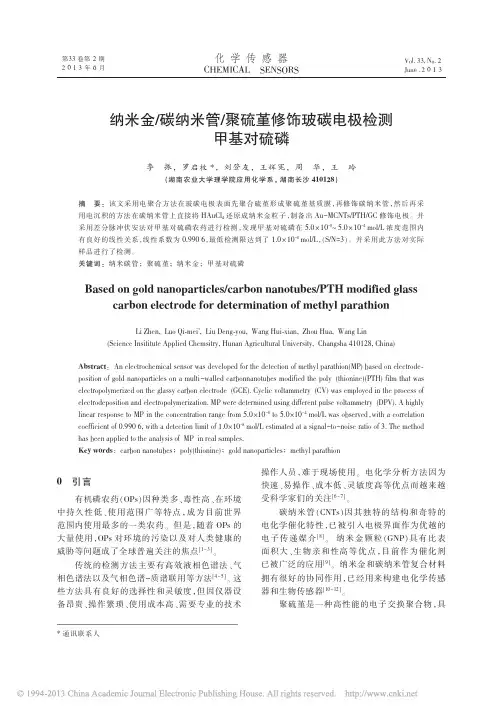
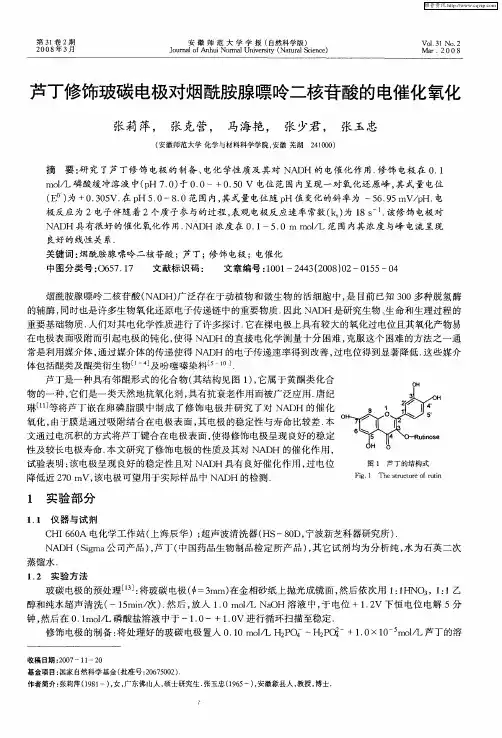
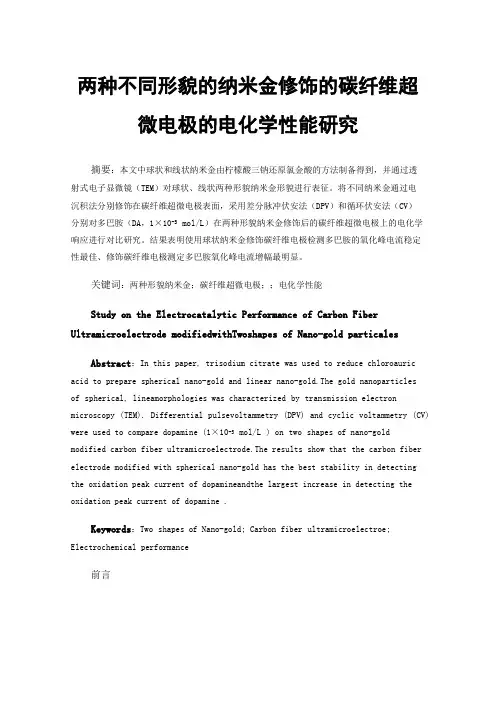
两种不同形貌的纳米金修饰的碳纤维超微电极的电化学性能研究摘要:本文中球状和线状纳米金由柠檬酸三钠还原氯金酸的方法制备得到,并通过透射式电子显微镜(TEM)对球状、线状两种形貌纳米金形貌进行表征。
将不同纳米金通过电沉积法分别修饰在碳纤维超微电极表面,采用差分脉冲伏安法(DPV)和循环伏安法(CV)分别对多巴胺(DA,1×10-5mol/L)在两种形貌纳米金修饰后的碳纤维超微电极上的电化学响应进行对比研究。
结果表明使用球状纳米金修饰碳纤维电极检测多巴胺的氧化峰电流稳定性最佳、修饰碳纤维电极测定多巴胺氧化峰电流增幅最明显。
关键词:两种形貌纳米金;碳纤维超微电极;;电化学性能Study on the Electrocatalytic Performance of Carbon Fiber Ultramicroelectrode modifiedwithTwoshapes of Nano-gold particalesAbstract:In this paper, trisodium citrate was used to reduce chloroauric acid to prepare spherical nano-gold and linear nano-gold.The gold nanoparticlesof spherical, lineamorphologies was characterized by transmission electron microscopy (TEM). Differential pulsevoltammetry (DPV) and cyclic voltammetry (CV) were used to compare dopami ne (1×10-5mol/L) on two shapes of nano-goldmodified carbon fiber ultramicroelectrode.The results show that the carbon fiber electrode modified with spherical nano-gold has the best stability in detecting the oxidation peak current of dopamineandthe largest increase in detecting the oxidation peak current of dopamine .Keywords:Two shapes of Nano-gold; Carbon fiber ultramicroelectroe; Electrochemical performance前言纳米材料性能独特[1],具备卓越的物理化学性质,对不同的复合纳米材料进行加工制作,可获得具有特定性质的复合型纳米材料。
![一种在抗坏血酸存在的条件下检测多巴胺的修饰玻碳电极、制备方法及应用[发明专利]](https://uimg.taocdn.com/7b07e60d81c758f5f71f67bf.webp)
专利名称:一种在抗坏血酸存在的条件下检测多巴胺的修饰玻碳电极、制备方法及应用
专利类型:发明专利
发明人:茆卉,梁家琛,张海凤,纪春光,宋溪明
申请号:CN201610005256.0
申请日:20160106
公开号:CN105572200A
公开日:
20160511
专利内容由知识产权出版社提供
摘要:本发明公开一种在抗坏血酸存在的条件下检测多巴胺的修饰玻碳电极,所述修饰玻碳电极为聚合离子液体/聚吡咯/氧化石墨烯纳米片修饰的玻碳电极,聚吡咯/氧化石墨烯纳米片中的聚吡咯与氧化石墨烯通过氢键的方式复合,聚合离子液体通过非共价键的方式与聚吡咯/氧化石墨烯纳米片相连。
该修饰玻碳电极可作为一种新型的电化学生物传感器,可用于在抗坏血酸存在下,实现对多巴胺的检测,具有制备方法简单、快速,选择性良好等优点。
申请人:辽宁大学
地址:110000 辽宁省沈阳市沈北新区道义南大街58号
国籍:CN
代理机构:沈阳杰克知识产权代理有限公司
代理人:胡洋
更多信息请下载全文后查看。
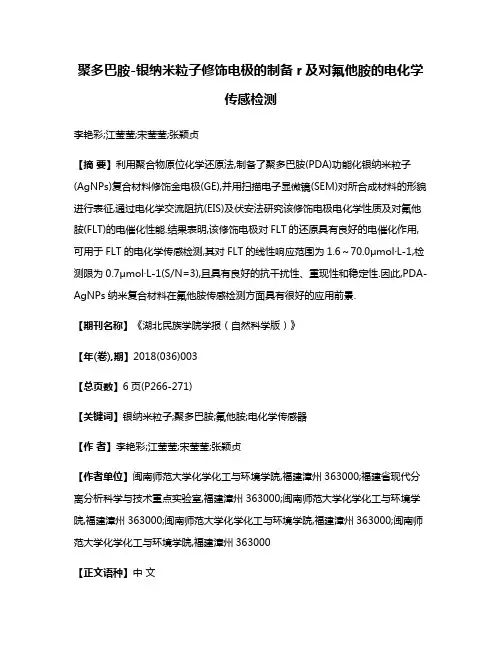
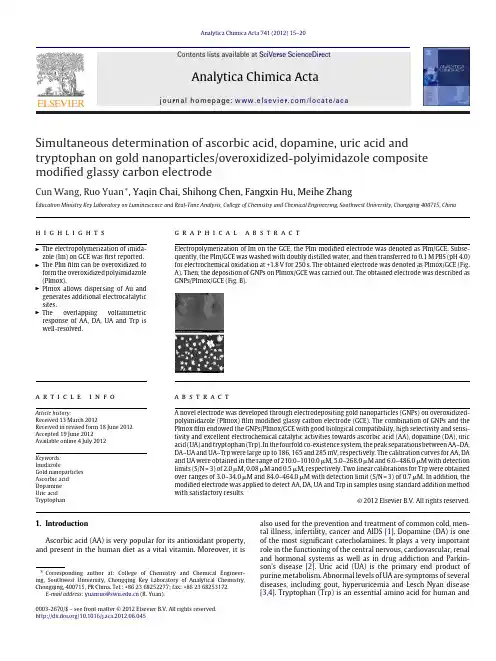
Analytica Chimica Acta 741 (2012) 15–20Contents lists available at SciVerse ScienceDirectAnalytica ChimicaActaj o u r n a l h o m e p a g e :w w w.e l s e v i e r.c o m /l o c a t e /a caSimultaneous determination of ascorbic acid,dopamine,uric acid and tryptophan on gold nanoparticles/overoxidized-polyimidazole composite modified glassy carbon electrodeCun Wang,Ruo Yuan ∗,Yaqin Chai,Shihong Chen,Fangxin Hu,Meihe ZhangEducation Ministry Key Laboratory on Luminescence and Real-Time Analysis,College of Chemistry and Chemical Engineering,Southwest University,Chongqing 400715,Chinah i g h l i g h t sThe electropolymerization of imida-zole (Im)on GCE was first reported. The PIm film can be overoxidized to form the overoxidized polyimidazole (PImox).PImox allows dispersing of Au and generates additional electrocatalytic sites. The overlapping voltammetric response of AA,DA,UA and Trp is well-resolved.g r a p h i c a la b s t r a c tElectropolymerization of Im on the GCE,the PIm modified electrode was denoted as PIm/GCE.Subse-quently,the PIm/GCE was washed with doubly distilled water,and then transferred to 0.1M PBS (pH 4.0)for electrochemical oxidation at +1.8V for 250s.The obtained electrode was denoted as PImox/GCE (Fig.A).Then,the deposition of GNPs on PImox/GCE was carried out.The obtained electrode was described as GNPs/PImox/GCE (Fig.B).a r t i c l ei n f oArticle history:Received 13March 2012Received in revised form 18June 2012Accepted 19June 2012Available online 4 July 2012Keywords:ImidazoleGold nanoparticles Ascorbic acid Dopamine Uric acid Tryptophana b s t r a c tA novel electrode was developed through electrodepositing gold nanoparticles (GNPs)on overoxidized-polyimidazole (PImox)film modified glassy carbon electrode (GCE).The combination of GNPs and the PImox film endowed the GNPs/PImox/GCE with good biological compatibility,high selectivity and sensi-tivity and excellent electrochemical catalytic activities towards ascorbic acid (AA),dopamine (DA),uric acid (UA)and tryptophan (Trp).In the fourfold co-existence system,the peak separations between AA–DA,DA–UA and UA–Trp were large up to 186,165and 285mV,respectively.The calibration curves for AA,DA and UA were obtained in the range of 210.0–1010.0M,5.0–268.0M and 6.0–486.0M with detection limits (S/N =3)of 2.0M,0.08M and 0.5M,respectively.Two linear calibrations for Trp were obtained over ranges of 3.0–34.0M and 84.0–464.0M with detection limit (S/N =3)of 0.7M.In addition,the modified electrode was applied to detect AA,DA,UA and Trp in samples using standard addition method with satisfactory results.© 2012 Elsevier B.V. All rights reserved.1.IntroductionAscorbic acid (AA)is very popular for its antioxidant property,and present in the human diet as a vital vitamin.Moreover,it is∗Corresponding author at:College of Chemistry and Chemical Engineer-ing,Southwest University,Chongqing Key Laboratory of Analytical Chemistry,Chongqing,400715,PR China.Tel.:+862368252277;fax:+862368253172.E-mail address:yuanruo@ (R.Yuan).also used for the prevention and treatment of common cold,men-tal illness,infertility,cancer and AIDS [1].Dopamine (DA)is one of the most significant catecholamines.It plays a very important role in the functioning of the central nervous,cardiovascular,renal and hormonal systems as well as in drug addiction and Parkin-son’s disease [2].Uric acid (UA)is the primary end product of purine metabolism.Abnormal levels of UA are symptoms of several diseases,including gout,hyperuricemia and Lesch Nyan disease [3,4].Tryptophan (Trp)is an essential amino acid for human and0003-2670/$–see front matter © 2012 Elsevier B.V. All rights reserved./10.1016/j.aca.2012.06.04516 C.Wang et al./Analytica Chimica Acta741 (2012) 15–20herbivores[5].In addition,it has been implicated as a possible cause of schizophrenia in people who cannot properly metabo-lize it[6].It is known to all,AA,DA,UA and Trp usually coexist in biological samples.Therefore,a sensitive and selective method for their simultaneous determination is highly desirable for analyt-ical application and diagnostic research.A major problem for their simultaneous determination is that AA,DA,UA and Trp undergo the same potential at conventional electrodes with a pronounced foul-ing effect,resulting in poor reproducibility.Besides,many reported detection methods were complicated,expensive,and suffered from sensitivity as well as selectivity.To overcome these problems,many materials have been employed to modify electrodes,such as gold nanocluster/overoxidized-polypyrrole composite[7]and iron(III) doped zeolite[5].Recently,polymerfilm and metal nanoparticles have been arose great attentions due to their wide applications in thefields of chemical modified electrodes[8,9].As is well-known,metal nanoparticles especially gold nanoparticles(GNPs)can enhance the conductivity,facilitate the electron transfer and improve the detection limit of electrode[10].Among various types of conduc-tive polymers[11–14],polyimidazole(PIm)has many attractive features,for example thefilm is very stable and hard to be taken off from the surface unless the electrode is heavily polished.It has high selectivity and sensitivity due to the chemically stable homogeneousfilm with controlled thickness[12].Furthermore, the PImfilm can be further overoxidized at higher potentials to form the overoxidized-polyimidazole(PImox),resulting in an insulating membrane with lower background current.The overox-idizedfilm has large surface area because of the porous structure. Moreover,the porous structure of the PImoxfilm is in favor of dispersing metal nanoparticles into the polymer matrix and gener-ates additional electrocatalytic sites[7,15].Since the combination of the polymerfilms and metal nanoparticles not only signifi-cantly improve the electrocatalytic properties of substrates and the stability and reproducibility of the electrode but also decrease the overpotential and increase the reaction rate[14].For exam-ple,gold nanocluster/overoxidized-polypyrrole composite[7]and overoxidized poly(N-acetylaniline)[16]modified electrodes have been used for the determination of DA or serotonin.However, compared with the methods mentioned above,the modified electrode in our work exhibits its peculiar advantages,such as higher sensitivity,selectivity,reproducibility and relatively low cost.In this study,a novel electrode based on the PImoxfilm incorporated with GNPs was constructed for the simultaneous determination of AA,DA,UA and Trp.Due to the synergic effect between PImox and GNPs,the overlapping voltammetric response of AA,DA,UA and Trp is well-resolved from each other with lowered oxidation pared with the GNPs/GCE,PIm/GCE and PImox/GCE,the GNPs/PImox/GCE exhibited obviously enhanced responses towards AA,DA,UA and Trp.Furthermore,the practi-cal application was investigated using standard addition method and satisfactory results were obtained.2.Materials and methods2.1.ChemicalsChloroauric acid(HAuCl4)and imidazole(Im)were pur-chased from Sigma Chemical Co.(St.Louis,Mo,USA).Sodium dodecylsulfate(SDS),uric acid,tryptophan,ascorbic acid and dopamine were purchased from Chemical Reagent Co.(Chongqing, China).Phosphate buffer solutions(PBS)(0.1M)at various pH were prepared using0.1M Na2HPO4,0.1M KH2PO4,and 0.1M KCl.Double-distilled water was used throughout the experiments.2.2.ApparatusAll electrochemical experiments were performed with a CHI 660D electrochemical workstation(Shanghai Chenhua Instrument Co.,China).The conventional three-electrode system included a modified glassy carbon electrode(GCE)as working electrode,a platinum wire as auxiliary electrode and a saturated calomel electrode(SCE)as a reference electrode.The morphological char-acterization of thefilms was examined by scanning electron microscope(SEM,S-4800,Hitachi,Japan).All measurements were carried out at room temperature.2.3.Preparation of GNPs/PImox modified electrodeThe glassy carbon electrode(diameter4.0mm)was successively polished to a mirror using0.3and0.05m alumina slurry.After-ward,the electrode was washed thoroughly with ethanol and water and dried at room temperature.Electropolymerization of Im on the GCE was carried out by8 circles between–0.2and0.8V at0.1V s–1in0.1M SDS containing 0.1M Im[14].The SDS was used as assisted reagent and support-ing electrolyte for the electropolymerization of Im[14].Moreover, the SDS could form a complex with Im,resulting in porous struc-ture with a large surface area[14,17].Eight circles were chosen to deposit the Imfilm because the highest sensitivity towards the biomolecules was obtained under this case(Fig.1S).Subsequently, the PIm modified electrode(PIm/GCE)was washed with double distilled water,and then transferred to0.1M PBS(pH4.0)for elec-trochemical oxidation at+1.8V to250s,obtaining PImox modified electrode(PImox/GCE).The deposition of GNPs on PImox/GCE was carried out in a mixture of H2SO4(0.5M)and HAuCl4(1mM)at –0.2V for80s[9].The80s was the optimal deposition time accord-ing to our studies(Fig.2S).The obtained electrode was described as GNPs/PImox/GCE.For comparison,PIm/GCE,PImox/GCE and GNPs/GCE were pre-pared using the same procedure.3.Results and discussion3.1.SEM of the modified electrodeThe morphology of modifiedfilms was investigated by scanning electron microscopy(SEM).As shown in Fig.1A,PImoxfilm appears a comparatively smooth and homogeneous surface.However,after electrodepositing GNPs,flower-like nanostructures were observed in Fig.1B,indicating that GNPs were obtained.As seen from Fig.1B, the particle size of theflower-like GNPs was ranging from250to 450nm.Also,the GNPs look very pretty,and the keen-edged leaves make the surface of GNPs very rough and many leaves possess a large specific surface area.The results indicated that the PImox and GNPs/PImoxfilms were effectively immobilized on the electrode surface.3.2.The influence of pH on the oxidation of AA,DA,UA and Trp at the GNPs/PImox/GCEThe effect of pH value for the simultaneous determination of AA, DA,UA and Trp at GNPs/PImox/GCE was thoroughly investigated by differential pulse voltammetry(DPV).Fig.2showed the effect of pH value on the peak current and peak potential.From Fig.2A,the peak current of AA and Trp initially increased and reached a maximum value at pH4.0,then,another maximum value was observed at neu-tral pH with pH increasing.DA and UA give the highest response at pH4.0with pH increasing.The reason may be related to the change in electrostatic interaction between the four substances and GNPs/PImoxfilm.In Fig.2B,the linear regression equations for AA,C.Wang et al./Analytica Chimica Acta741 (2012) 15–2017Fig.1.SEM images of(A)PImox/GCE and(B)GNPs/PImox/GCE.DA,and Trp were obtained as:E DA(mV)=421.30–18.08pH,E UA (mV)=628.59–27.23pH and E Trp(mV)=789.21–17.37pH.All the peak potentials of AA,DA,UA and Trp shifted to more negative val-ues with the pH increasing.This is a consequence of a deprotonation step involved in all oxidation processes that is facilitated at higher pH values[18].AA(p K a=4.10),DA(p K a=8.87),UA(p K a=5.7)and Trp(p K a=5.89)exist as cationic form in pH4.0PBS(0.1M)[12]. Moreover,overoxidation in the Im ring leads to effective collection of the cationic species[7,19].It was expected that cationic forms of AA,DA,UA and Trp were electrostatically interacted with the poly-mer backbone at pH4.0[12].In addition,the maximum separation of peak potentials for AA–DA,DA–UA and UA–Trp is observed at pH 4.0.In order to obtain a high sensitivity and selectivity,pH4.0PBS (0.1M)was selected for further experiments.3.3.Cyclic voltammetric behaviors of the modified electrodeFig.3A showed the cyclic voltammograms(CVs)of different modified electrodes in0.1M PBS(pH4.0).As seen from Fig.3A, PImox/GCE(curve b)showed almost the same background current with the bare GCE(curve a),indicating anodic polarization at+1.8V maybe turn the PImfilm into an insulating PImoxfilm with the loss of electroactivity[20].However,after modified with GNPs,the background signal increased for GNPs/PImox/GCE(curve c),and this may be resulted from the larger effective surface area of GNPs. The inset Fig.3A showed the electropolymerization process.The Fig.2.Effect of pH on(A)the peak current and(B)the peak potential for the oxi-dation of150M AA,15M DA,80M UA and80M Trp in0.1M PBS(pH4.0). DPV conditions:scan rate,20mV s–1;amplitude,50mV;pulse width,50ms;pulse period,200ms.anodic peak potentials tended to be stable after8circles,suggesting a self-adjustment of the polymerfilm thickness at the GCE[21,22].The ability of GNPs/PImox/GCE to promote the voltammetric resolution of AA,DA,UA and Trp was investigated.Control exper-iments for the simultaneous determination of AA,DA,UA and Trp were carried out by CV at PIm/GCE,PImox/GCE,GNPs/GCE and GNPs/PImox/GCE,respectively.As can be seen from Fig.3B, PIm/GCE(curve a)and GNPs/GCE(curve c)only showed a broad and overlapped anodic peaks in the fourfold mixture.On the PImox/GCE (curve b)three peaks appeared at295,485and795mV for DA, UA and Trp,respectively,but simultaneous determination of AA, DA,UA and Trp could not be obtained due to the indistinguish-able and small response to AA.In contrast,the modification of the GCE surface with GNPs/PImoxfilm(curve d)resolved the merged voltammetric peak into four well-defined peaks at poten-tials around136,320,485and770mV with a remarkable increase in peak current for AA,DA,UA and Trp,respectively.The reasons for the oxidation of AA,DA,UA and Trp at a wide potential sep-aration are ascribed as follows:Firstly,the GNPs enhanced the catalytic activity of PImox/GCE by increasing the peak current due to the increasing electronic conductivity and effective surface area [21].Secondly,during the overoxidization process,higher density of groups such as C O,COO−,C OH and OH can be generated on the backbone of PImoxfilm.The existence of C O,COO−,C OH and OH on the PImoxfilm could provide a selective interface18 C.Wang et al./Analytica Chimica Acta 741 (2012) 15–20Fig.3.(A)CV responses of (a)bare GCE,(b)PImox/GCE and (c)GNPs/PImox/GCE in 0.1M PBS (pH 4.0).Inset of part (A)shows the CVs of polymerization of Im (0.1M)in 0.1M SDS solution on GCE in the potential range from –0.2to 0.8V.Scan rate,0.1V s –1;8circles.(B)CVs at (a)PIm/GCE,(b)PImox/GCE,(c)GNPs/GCE and (d)GNPs/PImox/GCE in 0.1M PBS (pH 4.0)containing 200M AA,20M DA,50M UA and 50M Trp.for the molecular interaction of AA,DA,UA and Trp via hydro-gen bonds with the proton-donating group such as NH and OH [15,16,21].Thirdly,AA,DA,UA and Trp exist as cationic form at pH 4.0.In addition,overoxidation in the Im ring leads to an effective rejection of the anionic species and preferential collection of the cationic species [19,23].It was expected that protonated forms of AA,DA,UA and Trp were electrostatically interacted with the poly-mer backbone.Thus,it effectively catalyzed the oxidation of four substances at low pH.Fourthly,the selective promising feature of PImox film especially the composite with GNPs imparted superior selectivity and sensitivity towards the AA,DA,UA and Trp [13].In a word,the synergic effect of PImox film and the GNPs endowed the GNPs/PImox/GCE with a lower detection limit,wider linear range,better electricity and higher selectivity and sensitivity than that of other electrodes in the literature (Table 1).3.4.Simultaneous determination of AA,DA,UA and TrpDPV was employed to detect AA,DA,UA and Trp because of its higher current sensitivity and better resolution than CV.In four-fold mixture,the electro-oxidation processes of AA,DA,UA and Trp in the mixture were investigated when the concentration of one species changed,whereas those of other three species are kept con-stant.Fig.4A depicted the DPV of AA containing 50M UA,15M DA and 50M Trp.The peak current of AA increased linearly with an increase in AA concentration from 210.0to 1010.0M,with theT a b l e 1C o m p a r i s o n o f t h e r e s p o n s e c h a r a c t e r i s t i c s o f d i f f e r e n t m o d i fie d e l e c t r o d e s .E l e c t r o d e m a t e r i a l sL i n e a r r a n g e (M )D e t e c t i o n l i m i t (M )P e a k p o t e n t i a l (V )R e f e r e n c eA AD AU AT r pA AD AU AT r pA AD AU AT r pF e 3+Y /Z C M E 0.6–100–0.3–7000.2–1500.21–0.080.06––––[5]M W C N T –F e N A Z –C H 7.77–8337.35–8330.23–83.30.074–34.51.111.050.0330.011––––[6]G N P /c h o l i n e –0.2–801.2–100––0.120.6––0.230.37–[9]2-a m i n o -1,3,4-t h i a d i a z o l e 30–3005–5010–100–2.010.330.19–0.200.330.49–[12]O v e r o x i d i z e d p o l y (N -a c e t y l a n i l i n e )–0.50–20.0–––0.0168–––0.12––[24]p o l y -c h r o m o t r o p e 2B –2.0–80.0–––0.30–––0.349––[25]G N P s /P I m o x210.0–1010.05.0–268.06.0–486.03.0–34.084.0–464.02.00.080.50.70.1360.3200.4850.770T h i s w o r kC.Wang et al./Analytica Chimica Acta741 (2012) 15–2019Fig.4.DPVs at the GNPs/PImox/GCE in0.1M PBS(pH4.0)(A)containing50M UA,15M DA,50M Trp and different concentrations of AA(from inner to outer):210, 310,460,610,710,810,960,1010M;(B)containing100M AA,50M UA,50M Trp and different concentrations of DA(from inner to outer):5,10,18,28,38,88,168, 268M;(C)containing100M AA,15M DA,50M Trp and different concentrations of UA(from inner to outer):6,11,36,86,166,266,366,486M and(D)containing 150M AA,20M UA,5M DA and different concentrations of Trp(from inner to outer):3,6,11,19,34,84,164,314,464M.Insets:plots of Ip vs.concentration for AA, DA,UA and Trp,respectively.linear function I p,AA(A)=23.02+0.01584C AA(M)(R=0.9975),and a detection limit of2.0M(S/N=3).Fig.4B illustrated the DPVof DA containing100M AA,50M UA and50M Trp.The linearrelationship between the peak current and the concentration of DAwas obtained in the concentration range of5.0to268.0M.Thelinear function was expressed as I p,DA(A)=17.26+0.07882C DA(M)(R=0.9827),and a detection limit of0.08M(S/N=3)wasobtained.Similarly,Fig.5C depicted the DPV response of UAinFig.5.DPVs of simultaneous determination of AA,DA,UA and Trp using GNPs/PImox modified GCE in0.1M PBS(pH4.0).Concentrations of the four compounds:AA(60, 120,180,280,380,480,680,920M),DA(5,10,15,20,25,30,40,60M),UA(5, 10,15,20,28,36,54,63M)and Trp(5,10,15,20,25,30,40,60M).the presence of100M AA,15M DA and50M Trp,which exhibited a linear relationship in the concentration range of6.0–486.0M,and its linear regression equation was defined asI p,UA(A)=10.59+0.03220C UA(M)(R=0.9898).The detection limit of0.5M(S/N=3)for UA was observed.Fig.5D illustrated the DPV of Trp containing50M AA,20M UA and5M DA.Two lin-ear calibration ranges of3.0–34.0M,with the linear function I p,Trp (A)=9.549+0.2414C Trp(M)(R=0.9362)and84.0–464.0M, and the linear function I p,Trp(A)=18.18+0.03716C Trp(M) (R=0.9632)were obtained for the Trp determination.The detec-tion limit was found to be0.7M(S/N=3).The relative standard deviations(RSD)for determining AA,DA,UA and Trp(n=10)were 7.09%,4.37%,5.67%and2.23%,respectively.The drift of the oxida-tion peaks of AA,DA,UA and Trp were observed for further addition of the respective analytes.In addition,DPVs were also performed at GNPs/PImox/GCE while changing the concentrations of AA,DA, UA and Trp simultaneously(Fig.5).3.5.Interferences,stability and reproducibilityIn order to evaluate the ability of anti-interference,several com-pounds were selected.It was found that no significant interference for the detection of AA(150M),DA(10M),UA(50M)and Trp(50M)was observed for these compounds:NaCl,KCl,KNO3, CaCl2,MgSO4,ZnCl2,methenamine,ethylenediaminetetraacetic acid disodium salt,glucose,l-cysteine,glutathione,folic acid and levodopa.Stability of the GNPs/PImox/GCE was also investigated. The modified electrode was stored at room temperature when not used.The response of the electrode lost approximately6.3%,20 C.Wang et al./Analytica Chimica Acta741 (2012) 15–20Table2Determination of AA,DA,UA and Trp in dopamine hydrochloride injection,vitamin C tablets,human urine and serum samples.Sample Detected a(M)Added(M)Found a(M)Recovery(%) Urine1Uric acid36.3±1.710.045.0±1.397.2Ascorbic acid40.039.8±1.199.5Dopamine0.50.5±0.02100.0tryptophan30.030.5±0.7101.7Urine2Uric acid26.8±1.120.046.4±0.999.1Ascorbic acid80.081.3±2.4101.6Dopamine 2.5 2.4±0.196.0tryptophan40.040.1±1.0100.3 Serum1Uric acid12.1±0.415.026.8±0.698.9Ascorbic acid100.0100.2±3.7100.2Dopamine 2.0 1.9±0.195.0tryptophan50.050.2±1.8100.4 Serum2Uric acid13.6±0.620.035.0±0.9104.2Ascorbic acid150.0148.2±4.598.8Dopamine 1.0 1.0±0.04100.0tryptophan40.039.8±1.099.5 Vitamin C tablets Ascorbic acid399.0±10.250.0487.7±19.2108.6Dopamine 1.0 1.0±0.08100.0Uric acid10.09.9±0.699.0tryptophan40.039.0±1.197.5 Dopamine injection Ascorbic acid200.0207.7±4.9103.9Dopamine93.2±3.5 1.592.5±1.297.7Uric acid50.051.8±2.2103.6tryptophan50.051.3±1.8102.6All samples were analyzed using standard addition method(n=3).a Mean value±standard deviation(n=3).3.2%,5.6%and5.4%for AA,DA,UA and Trp of its original response after13days,respectively.The relative standard deviation(RSD) (n=10)for all these species was less than7.09%.Thus,the pro-posed electrode showed a high stability and good reproducibility and anti-interference ability.3.6.Sample analysisDopamine hydrochloride injection,vitamin C tablets,human urine and serum samples were selected for analysis using the stan-dard addition method.All samples were diluted with0.1M PBS (pH4.0)before the measurements to prevent the matrix effect of authentic samples.Then,appropriate amount of each sample was added into5mL0.1M PBS(pH4.0),respectively.To ascer-tain the correctness of the results,the samples were spiked with certain amounts of standard AA,DA,UA and Trp and then the total values were detected using DPV.The results were listed in Table2.The recovery rates of the samples ranged between95.0% and108.6%,showing that the proposed method could be effectively used for the determination of AA,DA,UA and Trp in commercial samples.4.ConclusionsIn conclusion,a novel GNPs/PImox/GCE was constructed to determine AA,DA,UA and Trp in this work.The modified elec-trode not only showed high selectivity towards the oxidation of AA, DA,UA and Trp,but also resolved their overlapped oxidation peaks into four well-defined peaks,respectively.This was attributed to a decrease of the reduction potential ability of PImox,the very high electron transfer rate of GNPs that can remarkable increase in peak current towards the compounds,and the remarkable syner-gistic effects of PImox and GNPs.The simple fabrication procedure, low detection limit,high selectivity,good stability and sensitivity, suggest that this modified electrode is an attractive candidate for practical applications.AcknowledgmentsThe National Natural Science Foundation of China(21075100), the Ministry of Education of China(Project708073),the Nature Science Foundation of Chongqing City(CSTC-2009BA1003, 2011BA7003)and State Key Laboratory of Electroanalytical Chem-istry(SKIEAC2010009),China supported this work.Appendix A.Supplementary dataSupplementary data associated with this article can be found,in the online version,at /10.1016/j.aca.2012.06.045. References[1]N.F.Atta,M.F.El-Kady,G.Ahmed,Anal.Biochem.400(2010)78–88.[2]J.W.Mo,B.Ogorevc,Anal.Chem.73(2001)1196–1202.[3]P.Elena,Y.Kubota,D.A.Tryk,A.Fujishima,Anal.Chem.72(2000)1724–1727.[4]J.M.Zen,P.J.Chen,Anal.Chem.69(1997)5087–5093.[5]A.Babaei,M.Zendehdel,B.Khalilzadeh,A.Taheri,Colloids Surf.B66(2008)226–232.[6]M.Noroozifar,M.Khorasani-Motlagh,R.Akbari,M.B.Parizi,Biosens.Bioelec-tron.28(2011)56–63.[7]J.Li,X.Q.Lin,Sens.Actuators B124(2007)486–493.[8]A.L.Liu,S.B.Zhang,W.Chen,X.H.Lin,X.H.Xia,Biosens.Bioelectron.23(2008)1488–1495.[9]P.Wang,Y.X.Li,X.Huang,L.Wang,Talanta73(2007)431–437.[10]S.Thiagarajan,S.M.Chen,Talanta74(2007)212–222.[11]K.C.Lin,T.H.Tsai,S.M.Chen,Biosens.Bioelectron.26(2010)608–614.[12]P.Kalimuthu,S.A.John,Talanta80(2010)1686–1691.[13]X.H.Jiang,X.Q.Lin,Anal.Chim.Acta537(2005)145–151.[14]Y.X.Li,P.Wang,L.Wang,X.Q.Lin,Biosens.Bioelectron.22(2007)3120–3125.[15]S.Ulubay,Z.Dursun,Talanta80(2010)1461–1466.[16]X.M.Tu,Q.J.Xie,S.Y.Jiang,S.Z.Yao,Biosens.Bioelectron.22(2007)2819–2826.[17]D.R.Albano,F.Sevilla,Sens.Actuators B121(2007)129–134.[18]B.Habibia,M.H.Pournaghi-Azar,Electrochim.Acta55(2010)5492–5498.[19]Z.D.Chen,Y.Takei,B.A.Deore,T.Nagaoka,Analyst125(2000)2249–2254.[20]L.S.Van Dyke,C.R.Martin,Langmuir6(1990)1118–1123.[21]A.A.Ensafi,M.Taei,T.Khayamian,A.Arabzadeh,Sens.Actuators B147(2010)213–221.[22]H.Yao,Y.Sun,X.Lin,Y.Tang,L.Huang,Electrochim.Acta52(2007)6165–6171.[23]M.S¸ahin,Y.S¸ahin,A.Özcan,Sens.Actuators B133(2008)5–14.[24]L.Z.Zheng,S.G.Wu,X.Q.Lin,L.Nie,L.Rui,Analyst126(2001)736–738.[25]X.H.Lin,Q.Zhuang,J.H.Chen,S.B.Zhang,Y.J.Zheng,Sens.Actuators B125(2007)240–245.。
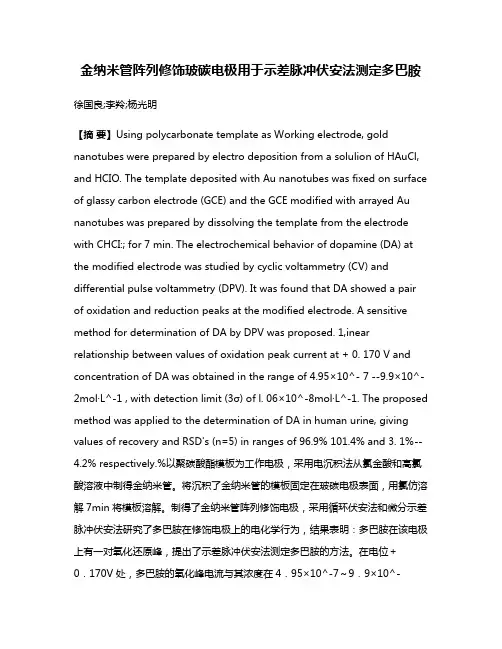
金纳米管阵列修饰玻碳电极用于示差脉冲伏安法测定多巴胺徐国良;李羚;杨光明【摘要】Using polycarbonate template as Working electrode, gold nanotubes were prepared by electro deposition from a solulion of HAuCl, and HCIO. The template deposited with Au nanotubes was fixed on surface of glassy carbon electrode (GCE) and the GCE modified with arrayed Au nanotubes was prepared by dissolving the template from the electrode with CHCI:; for 7 min. The electrochemical behavior of dopamine (DA) at the modified electrode was studied by cyclic voltammetry (CV) and differential pulse voltammetry (DPV). It was found that DA showed a pair of oxidation and reduction peaks at the modified electrode. A sensitive method for determination of DA by DPV was proposed. 1,inear relationship between values of oxidation peak current at + 0. 170 V and concentration of DA was obtained in the range of 4.95×10^- 7 --9.9×10^-2mol·L^-1 , with detection limit (3σ) of l. 06×10^-8mol·L^-1. The proposed method was applied to the determination of DA in human urine, giving values of recovery and RSD's (n=5) in ranges of 96.9% 101.4% and 3. 1%--4.2% respectively.%以聚碳酸酯模板为工作电极,采用电沉积法从氯金酸和高氯酸溶液中制得金纳米管。
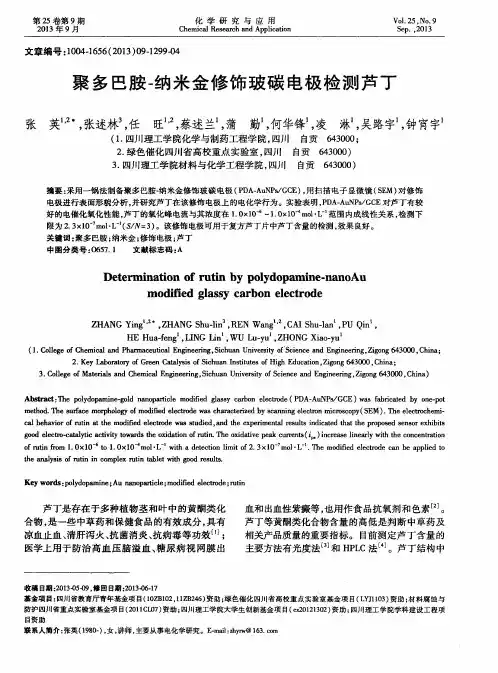
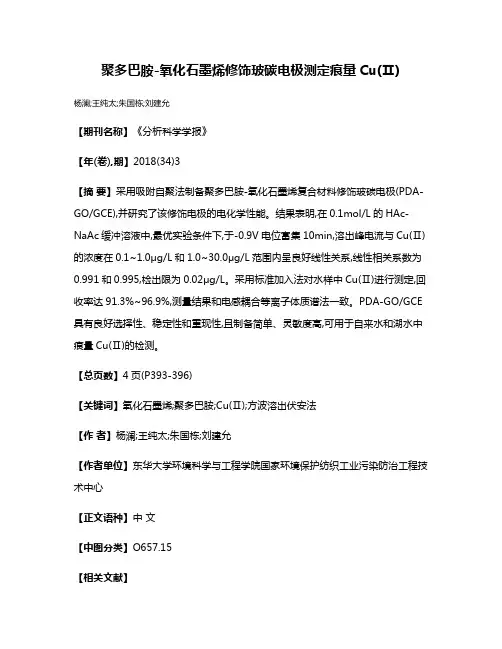
聚多巴胺-氧化石墨烯修饰玻碳电极测定痕量Cu(Ⅱ)杨澜;王纯太;朱国栋;刘建允【期刊名称】《分析科学学报》【年(卷),期】2018(34)3【摘要】采用吸附自聚法制备聚多巴胺-氧化石墨烯复合材料修饰玻碳电极(PDA-GO/GCE),并研究了该修饰电极的电化学性能。
结果表明,在0.1mol/L的HAc-NaAc缓冲溶液中,最优实验条件下,于-0.9V电位富集10min,溶出峰电流与Cu(Ⅱ)的浓度在0.1~1.0μg/L和1.0~30.0μg/L范围内呈良好线性关系,线性相关系数为0.991和0.995,检出限为0.02μg/L。
采用标准加入法对水样中Cu(Ⅱ)进行测定,回收率达91.3%~96.9%,测量结果和电感耦合等离子体质谱法一致。
PDA-GO/GCE 具有良好选择性、稳定性和重现性,且制备简单、灵敏度高,可用于自来水和湖水中痕量Cu(Ⅱ)的检测。
【总页数】4页(P393-396)【关键词】氧化石墨烯;聚多巴胺;Cu(Ⅱ);方波溶出伏安法【作者】杨澜;王纯太;朱国栋;刘建允【作者单位】东华大学环境科学与工程学院国家环境保护纺织工业污染防治工程技术中心【正文语种】中文【中图分类】O657.15【相关文献】1.以聚(3-己基噻吩)-石墨烯-Nafion修饰的玻碳电极为工作电极示差脉冲伏安法测定细颗粒物PM2.5中铅的含量 [J], 金党琴;龚爱琴;丁邦东;周慧;田连生;韩磊;黄文江2.聚茜素红-还原态氧化石墨烯修饰玻碳电极测定苯二酚 [J], 朱超云;宋伟;许红林;姚琪3.纳米Cu2O-还原石墨烯复合修饰玻碳电极用于多巴胺的检测 [J], 贺全国;李广利;刘军;刘晓鹏;梁静;邓培红4.聚对氨基苯磺酸/石墨烯修饰玻碳电极伏安法测定痕量汞 [J], 许春萱;熊小琴;吴莹莹;马文杰5.聚苏木精/氧化石墨烯修饰玻碳电极测定水样中痕量铅和镉 [J], 许春萱;熊小琴;金紫荷;杨晶晶因版权原因,仅展示原文概要,查看原文内容请购买。

第21卷第1期阜阳师范学院学报(自然科学版 Vol.21.No.1 2004年3月 Journal of Fuyang Teachers College(Natural Science December2004多巴胺在纳米金修饰微玻碳电极上的电化学行为研究张宏1 金葆康2(1.安徽阜阳师范学院化学系,阜阳 236032; 2.安徽大学化学化工学院,合肥230039摘要:用电沉积的方式制备了纳米金修饰微玻碳电极,该修饰电极能分开多巴胺和抗坏血酸的氧化峰.研究了溶液p H值、磷酸缓冲溶液浓度对多巴胺电化学行为的影响.多巴胺氧化峰电流值与其浓度在5 10-6~1 10-4mol/ L范围内成线性关系.关键词:纳米金; 多巴胺; 微玻碳电极中图分类号:O651 文献标识码:A 文章编号:1004-4329(200401-0016-041 前言多巴胺是人体神经系统内一种重要的神经递质,人类许多疾病(如帕金森氏症都与其相对浓度有关[1].多巴胺有较强的电化学活性,但用裸电极测量其浓度时,有两个问题需要解决:一是低的电子转移速率;二是干扰物质,如抗坏血酸.人们利用Nafion[2,3]膜、含酸性基团的物质[4-6]制备修饰电极,使上述问题得到改善,但要实现快速测定,膜必需做得非常薄[7].近年来,微电极因独特的性能(如稳态扩散、ir降小、可实现活体检测等在神经递质研究领域取得较快发展[8-10].本文利用纳米金良好的生物共容性,制备了纳米金修饰微玻碳电极,并研究了多巴胺在该修饰电极上的电化学行为,发现纳米金能明显改善多巴胺的电子转移速率,并且能将多巴胺和抗坏血酸的氧化峰分开,从而消除了抗坏血酸的干扰.为实现多巴胺的活体检测提供了可能性.2 实验部分2.1 仪器与试剂Zeta Sizer3000HS纳米粒度测量仪(马尔文公司,英国;M283电化学系统(PARC,EG&G,美国;微玻碳电极( =10 m,E G&G,美国电化学实验采用三电极体系,微玻碳电极或纳米金修饰电极为工作电极,Ag/ AgCl/3mol/L KCl为参比电极,铂丝为对电极,文中所有电位均相对于参比电极.HAuCl4(上海试剂厂;盐酸多巴胺(DA HCl,Fluka,瑞士;抗坏血酸(AA HCl,上海试剂站分装厂;不同pH值0.1mol/L磷酸缓冲溶液(PBS采用混合不同比例的1mol/L KH2PO4和1mol/L K2HPO4溶液配制,用H3PO4和KOH调节pH值;其余试剂均为分析纯.DA和AA溶液均用磷酸缓冲溶液配制,配制前磷酸缓冲溶液均用氮气除氧.实验过程使用二次石英重蒸水,25 下进行.2.2 纳米金溶胶的制备与表征6nm金溶胶按Natan[11]的方法制备并用Zeta Sizer3000HS纳米粒度测量仪进行表征,其粒径与文献[11]报道基本一致.2.3 纳米金在微玻碳电极上的修饰将玻碳电极分别在湿润的金相砂纸(4000#和加有Al2O3粉末(0.05 m的麂皮上抛光成镜面,二次水收稿日期:2003-10-20基金项目:主要从事电分析化学的教学与研究,安徽省教育厅科研基金资助项目(2001kj185第一作者简介:张宏(1967-,男,安徽颍上人,硕士,阜阳师院化学系副教授.冲洗,置于金溶胶中,Ag/AgCl 为参比电极,铂丝为对电极于+1.5V 下保持20min,取出用二次水反复冲洗,得纳米金修饰微玻碳电极,记作NG/mGCE,置于PBS 中备用.3 结果与讨论3.1多巴胺的电化学响应图1 1 10-3mol/L DA(p H=7.0在裸微玻碳电极(a和纳米金修饰电极(b上的单扫描伏安曲线(扫速:5mV/s图1中曲线a 和b 分别为1 10-3mol/L DA(pH=7.0在裸微玻碳电极和纳米金修饰电极上的稳态单扫描伏安曲线.曲线a 呈 S 形,表明多巴胺在裸微玻碳电极上的电极过程受扩散控制,而曲线b 呈峰形,则表明多巴胺在纳米金修饰微玻碳电极上的电极过程为吸附过程,这一点也为图2中氧化峰电流值与扫速的关系所证实.图2 (15 10-4mol/L DA(p H=7.0在NG/mGCE 上不同扫速下的循环伏安曲线(2和氧化峰电流值与扫速的关系(扫速:=10,20,30,40,50,60,80,100,120,140,160mV/s将扫速从10mV/s 改变到160mV/s 分别测绘多巴胺在纳米金修饰微玻碳电极上的循环伏安曲线,如图2(1,且多巴胺氧化峰电流值与扫速成线性关系(图2(2,说明多巴胺在纳米金修饰微玻碳电极上的电极过程为吸附过程,与图1结论相吻合.利用图2(2中直线的斜率,根据公式i p =n 2F 2 vA/4RT [12]可算出电极表面的吸附量为 =3.70 10-11mol/c m 2.3.2 pH 值对多巴胺电化学行为的影响分别用不同pH 值的PBS 配制1 10-3mol/L DA 溶液,研究DA 的电化学行为随pH 值的变化(图3(1,结果发现:DA 的峰电位值Ep 随pH 的增加明显负移,因为DA 的氧化是脱质子的过程,在高pH 值下,氧化过程变得容易.Ep 和pH 的关系可用下式描述:Ep(mV=590.4-56.9pH,斜率为56.9,说明DA 的氧化为一两电子两质子的过程.同时峰电流在pH =2.0~8.0之间随pH 增加而增大,至pH=8.0时达到最大,随后,随pH 值的增大而显著下降.为保持和人体内相同的环境,以下的实验均在pH=7.0下进行.17第1期张宏等:多巴胺在纳米金修饰微玻碳电极上的电化学行为研究3.3 PBS浓度对多巴胺电化学行为的影响图3 (1不同p H 值下1 10-3mol/L DA 在NG/mGEC 上的循环伏安曲线(2DA 氧化峰电位值与p H 值的关系(p H=2,3,4,5,6,7,8,9,10用pH=7.0的0.01、0.03、0.05、0.1、0.5mol/L 的PBS 分别配制了1 10-3mol/L DA 溶液并测绘其循环伏安曲线,结果发现:随着PB S 的浓度的降低,多巴胺峰电流下降,氧化峰电位正移,这可能源于电活性物质的电迁移[13],因此,选择0.1mol/L 的PBS 作为测量介质.4抗坏血酸共存下多巴胺的电化学响应图4 5 10-5mol/L DA and5 10-3mol/L AA 的混合溶液在裸微玻碳电极(a和在NG/mGCE(b上的稳态伏安曲线(扫速:50mV/s图4表明:当有100倍的抗坏血酸存在时,在裸微玻碳电极上,AA 的氧化峰电位值与DA 相近,因此只得到一个宽峰(a;而在纳米金修饰微玻碳电极上,由于纳米金带负电荷,能吸引带正电荷的多巴胺而排斥带负电荷的抗坏血酸,使抗坏血酸氧化峰负移,从而与多巴胺的氧化峰分开(b,即,消除了抗坏血酸的干扰.因此可用这种方法在抗坏血酸共存下选择性地测量多巴胺.且多巴胺的氧化峰电流值与其浓度呈线性关系,线性方程为:i pa (nA=-0.084+0.10 106C DA ,相关系数为R=0.999.5 结论本文研究了神经递质-多巴胺在纳米金修饰微玻碳电极上的电化学行为,发现该修饰电极对抗坏血酸的氧化有较强的催化作用,使抗坏血酸的氧化峰电位值有较大负移,和多巴胺的氧化峰分开,从而消除了在测量多巴胺时抗坏血酸的干扰.18阜阳师范学院学报(自然科学版第21卷参考文献[1] 张文,许群,金利通等.过氧化聚吡咯膜修饰电极色谱电化学用于帕金森试验动物的研究.[J].分析化学,2001,29:133.[2] 邹明珠,胡枢.Nafion 修饰电极测定血液中的肾上腺素.[J].分析化学,1992,20:588.[3] 方禹之,于雁灵,何品刚.Nafion 修饰电化学活化碳纤维微电极测定去甲肾上腺素.[J].分析化学,1995,23:1440.[4] H.M.Zhang,N.Q.Li,Z.W.Zhu.Electrocatalytic response of dopamine at a DL-homocysteine self-assembled gold electrode.[J].Microchemical Journal,2000,64:277.[5] F.Malem, D.Mandler.Self-Assembled Monolayers in Electroanalytical Chemistry :Application of -Mercapto Carboxylic Acid Mono -layers for the Electrochemical Detection of Dopamine in the Presence of a High Concen tration of Ascorbic Acid.[J].Anal.Chem.,1993,65:37.[6] A.Dalmia, C.C.Liu,R.F.Savinell.Electrochemical behavior of gold electrodes modi fied with self-assembled monolayers with an acidic end group for selective detection of dopamine.[J].J.Electroanal.Chem.,1997,430:205.[7] Y.X.Sun, B.X.Ye,X.Y.Zhou.Study on the Determination of Neurotransmi tters Usi ng Poly(Neutral RedCoated Carbon Fiber M-i croelectrodes.[J].Microchemical Journal,1998,58:182.[8] Q.Wang,N.Jian g ,N.Q.Li.Electrocatalytic response of dopamine at a thiolactic acid self -assembled gold electrode.[J].M icro -chemical Journal,2001,68:77.[9] B.X.Ye,P.Xia,L.Lin.Determi nation of the neurotransmitter-norepinephrine in the presence of ascorbic acid using carbon fiber m-i croelectrodes activated by potentiostat.[J].M icrochemical Journal,2000,64:125.[10] P.Hern ndez,I.S nchez, F.Pat n.L.H.Hern ndez.Cyclic voltammetry determinati on of epinephrine wi th a carbon fiber ultramicro -electrode.[J].T alanta,1998,46:985.[11] R.B.Kenneth, A.P.Fox,M.J.Natan.Morphology -Dependent Electrochemistry of Cytochrome c at Au Colloid-ModifiedSnO2Electrode.[J].J.Am.Chem.Soc.,1996,118:1154.[12] 董绍俊,车广礼,谢远武.[M].化学修饰电极,北京:科学出版社,1995:p53.[13] 张剑荣,杨曦,张祖训.超微电极研究-电迁移对准稳态线性扫描伏安法的影响.[J].高等学校化学学报,1994,15:1454.The Study of Electrochemical Behavior of Dopamine atNano -gold Modified glassy Carbon MicroeletrodeZhang Hong , Jin Bao -kang(1.Department of Chemistry,Fuyang Teachers College,Fuyang ,236032;2.School of Chemistry and Chemical Eng i neering,Anhui Universi ty,Hefei,230039Abstract:The Nano-gold modified glassy carbon microelectrode ,which is prepared by electrodepositi on,can operate the oxidation peak of dopamine and ascorbicacid.Meanwhile the effect of pH value and concen tration of phosphate buffer solution (PBSon the electro -chemical behavior of dopamine is s tudied in this paper.The peak current of dopamine is in linear relationship with its concentration in the range of 5 10-6~1 10-4mol/L.Key words:nano-gold;dopamine;glassy carbon microelectrode.19第1期张宏等:多巴胺在纳米金修饰微玻碳电极上的电化学行为研究。
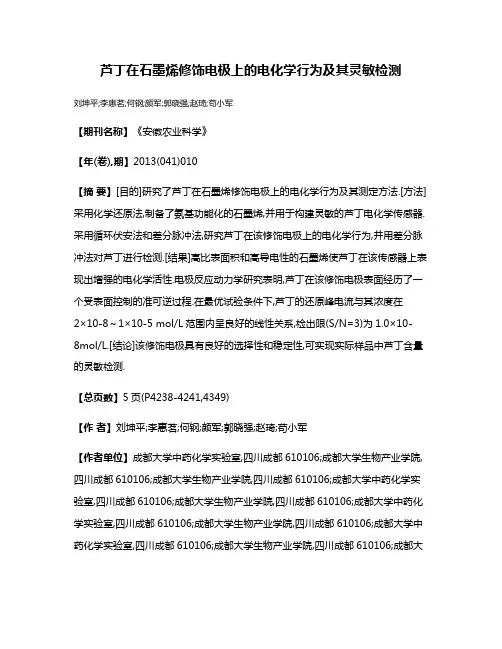
芦丁在石墨烯修饰电极上的电化学行为及其灵敏检测刘坤平;李惠茗;何钢;颜军;郭晓强;赵琦;苟小军【期刊名称】《安徽农业科学》【年(卷),期】2013(041)010【摘要】[目的]研究了芦丁在石墨烯修饰电极上的电化学行为及其测定方法.[方法]采用化学还原法,制备了氨基功能化的石墨烯,并用于构建灵敏的芦丁电化学传感器.采用循环伏安法和差分脉冲法,研究芦丁在该修饰电极上的电化学行为,并用差分脉冲法对芦丁进行检测.[结果]高比表面积和高导电性的石墨烯使芦丁在该传感器上表现出增强的电化学活性.电极反应动力学研究表明,芦丁在该修饰电极表面经历了一个受表面控制的准可逆过程.在最优试验条件下,芦丁的还原峰电流与其浓度在2×10-8~1×10-5 mol/L范围内呈良好的线性关系,检出限(S/N=3)为1.0×10-8mol/L.[结论]该修饰电极具有良好的选择性和稳定性,可实现实际样品中芦丁含量的灵敏检测.【总页数】5页(P4238-4241,4349)【作者】刘坤平;李惠茗;何钢;颜军;郭晓强;赵琦;苟小军【作者单位】成都大学中药化学实验室,四川成都610106;成都大学生物产业学院,四川成都610106;成都大学生物产业学院,四川成都610106;成都大学中药化学实验室,四川成都610106;成都大学生物产业学院,四川成都610106;成都大学中药化学实验室,四川成都610106;成都大学生物产业学院,四川成都610106;成都大学中药化学实验室,四川成都610106;成都大学生物产业学院,四川成都610106;成都大学中药化学实验室,四川成都610106;成都大学中药化学实验室,四川成都610106;成都大学生物产业学院,四川成都610106【正文语种】中文【中图分类】S131;Q652.9【相关文献】1.鞣酸功能化石墨烯修饰电极上芦丁的电化学行为及灵敏检测 [J], 李惠茗;张惠怡;赖祥文;梁立;刘坤平;苟小军2.芦丁在Nafion/纳米金@石墨烯修饰碳糊电极上的电化学行为及测定 [J], 匡云飞;邹建陵;李薇;杨颖群;许金生;冯泳兰;李玉明3.DNA修饰电极的研究Ⅷ.1,10-菲咯啉存在时钴离子在ssDNA修饰金电极上的电化学行为及痕量钴的检测 [J], 庞代文;陆琪;赵元弟;张敏4.芦荟大黄素在石墨烯/聚多巴胺/金复合纳米材料修饰电极上的电化学行为及检测[J], 阳敬;兰慧;吴其国;蓝伦礼;庄晨曦;赵佳5.核黄素在电化学还原石墨烯/Nafion修饰电极上的电化学行为及分析检测 [J], 马琦;李坤;张素芳;宋金萍;郭永;董川因版权原因,仅展示原文概要,查看原文内容请购买。
聚多巴胺纳米点是一种通过聚合多巴胺(polydopamine,简称PDA)来形成的纳米材料。
多巴胺是一种天然存在于生物体内的物质,它具有很强的粘附性和氧化性质。
利用这些性质,多巴胺可以被用于制备功能性纳米点。
聚多巴胺纳米点具有以下特点:
1. 多功能性:聚多巴胺纳米点可以通过表面修饰和功能化来实现多种功能,如控制释放药物、增强材料表面活性、催化反应等。
2. 易制备和可调控:聚多巴胺纳米点的制备方法相对简单,常见的方法是将多巴胺在碱性条件下溶解后与基底表面或其他物质进行反应。
此外,通过调节反应条件,如多巴胺溶液浓度、反应时间等,还可以控制纳米点的尺寸和形貌。
3. 生物相容性:多巴胺是一种天然存在于生物体内的物质,聚多巴胺纳米点具有较好的生物相容性,可以在生物体内应用于各种生物医学领域,如生物成像、药物输送等。
4. 高稳定性:聚多巴胺纳米点具有较好的稳定性,可以在广泛的温度和pH值条件下保持其结构和性能。
5. 可控释放性:通过改变聚多巴胺纳米点的结构和化学修饰,可以实现对载药物质的控制释放,有助于药物输送和治疗应用。
聚多巴胺纳米点在生物医学、材料科学和化学领域具有广泛的应用潜力,例如用于药物传递、组织工程、生物传感、水处理等。
它们的制备方法和应用研究仍在不断发展和探索中,以期更好地满足不同领域的需求。
聚多巴胺-纳米金修饰玻碳电极检测芦丁
张英;张述林;任旺;蔡述兰;蒲勤;何华锋;凌淋;吴路宇;钟宵宇
【期刊名称】《化学研究与应用》
【年(卷),期】2013(000)009
【摘要】采用一锅法制备聚多巴胺-纳米金修饰玻碳电极(PDA-AuNPs/GCE),用扫描电子显微镜(SEM)对修饰电极进行表面形貌分析,并研究芦丁在该修饰电极上的电化学行为。
实验表明,PDA-AuNPs/GCE对芦丁有较好的电催化氧化性能,芦丁的氧化峰电流与其浓度在1.0×10-6~1.0×10-4 mol· L-1范围内成线性关系,检测下限为2.3×10-7mol· L-1(S/N=3)。
该修饰电极可用于复方芦丁片中芦丁含量的检测,效果良好。
%The polydopamine-gold nanoparticle modified glassy carbon electrode ( PDA-AuNPs/GCE ) was fabricated by one-pot method.The surface morphology of modified electrode was characterized by scanning electron microscopy ( SEM).The electrochemi-cal behavior of rutin at the modified electrode was studied ,and the experimental results indicated that the proposed sensor exhibits good electro-catalytic activity towards the oxidation of rutin.The oxidative peak currents(ipa)increase linearly with the concentration of rutin from 1.0 ×10-6 to 1.0 ×10-4 mol· L-1 with a detection limit of 2.3 ×10-7 mol· L-1.The modified electrode can be applied to the analysis of rutin in complex rutin tablet with good results.
【总页数】4页(P1299-1302)
【作者】张英;张述林;任旺;蔡述兰;蒲勤;何华锋;凌淋;吴路宇;钟宵宇
【作者单位】四川理工学院化学与制药工程学院,四川自贡 643000; 绿色催化四川省高校重点实验室,四川自贡 643000;四川理工学院材料与化学工程学院,四川自贡 643000;四川理工学院化学与制药工程学院,四川自贡 643000; 绿色催化四川省高校重点实验室,四川自贡 643000;四川理工学院化学与制药工程学院,四川自贡 643000;四川理工学院化学与制药工程学院,四川自贡 643000;四川理工学院化学与制药工程学院,四川自贡 643000;四川理工学院化学与制药工程学院,四川自贡 643000;四川理工学院化学与制药工程学院,四川自贡 643000;四川理工学院化学与制药工程学院,四川自贡 643000
【正文语种】中文
【中图分类】O657.1
【相关文献】
1.聚(三聚氰胺)与金纳米粒共修饰玻碳电极用于芦丁的电化学测定 [J], 冯利彬;齐崴;苏荣欣;何志敏
2.吲哚乙酸在纳米金/碳纳米管/壳聚糖修饰玻碳电极上的电化学行为及其检测 [J], 张学钰;刘兴梅;刘伟禄;杨明;张志权
3.纳米金/碳纳米管/聚硫堇修饰玻碳电极检测甲基对硫磷 [J], 李振;罗启枚;刘登友;王辉宪;周华;王玲
4.二氧化铈纳米棒修饰玻碳电极的制备及其对芦丁的检测 [J], 汪美芳;张伟;方宾
5.芦荟大黄素在石墨烯/聚多巴胺/金复合纳米材料修饰电极上的电化学行为及检测[J], 阳敬;兰慧;吴其国;蓝伦礼;庄晨曦;赵佳
因版权原因,仅展示原文概要,查看原文内容请购买。